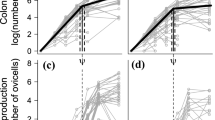Summary
This study documents size- and density-dependent growth (positive and negative), in the sea urchin Diadema antillarum. In the summer of 1983, an inverse relationship was found between Diadema test diameter and population density at seven sites in Lameshur Bay, St. John, United States Virgin Islands. The regression of this relationship improved when test diameter was plotted against density per unit grazing area. A field experiment demonstrated that 1) Diadema has the ability to reduce skeletal body size, and 2) direction (growth or shrinkage) and rate of growth can be predicted accurately based on the urchin's body size and population density. The ability to adjust body size as density fluctuates may allow Diadema to persist when density increases, by shrinking and reducing metabolic costs, and to take advantage of decreases in density, by increasing in size and fecundity.
Similar content being viewed by others
References
Carpenter RC (1981) Grazing by Diadema antillarum (Philippi) and its effect on the benthic algal community. J Mar Res 39:749–765
Dix TG (1972) Biology of Evechinus chloroticus (echinoidea: echinometridae) from different localities. 4. Age, growth, and size. NZ Jl Mar Freshwat Res 6:48–68
Ebert TA (1967) Negative growth and longevity in the purple sea urchin Stronglyocentrotus purpuratus (Stimpson). Science 157:557–558
Feder HM (1970) Growth and predation by the ochre sea star, Pisaster ochraceus (Brandt), in Monteray Bay, California. Ophelia 8:161–185
Hunte W, Cote I, Tomascik T (1986) On the dynamics of the mass mortality of Diadema antillarum in Barbados. Coral Reefs 4:135–139
Lawrence JM, Lane JM (1982) The utilization of nutrients by postmetamorphic echinoderms. In: Jangoux and Lawrence (eds) Echinoderm Nutrition. A.A. Balkema Press, Rotterdam, pp 331–371
Le Cren CD (1958) Observations on the growth of perch (Perca fluviatilis L.) over twenty-two years with special reference to the effects of temperature and changes in population density. J Anim Ecol 27:287–334
Lessios HA, Robertson DR, Cubit JD (1984) Spread of Diadema mass mortalities through the Caribbean. Science 226:335–337
Levitan DR (1988a) Asynchronous spawning and aggregative behavior in the sea urchin Diadema antillarum Philippi. In: Burke R (ed) Proc Sixth Int Echinoderm Conf. A.A. Balkema Press, Rotterdam (in press)
Levitan DR (1988b) Algal-urchin biomass responses following the mass mortality of Diadema antillarum Philippi at St. John. J Exp Mar Biol Ecol (in press)
Persson L (1985) Asymmetrical competition: are larger animals competitively superior? Am Nat 126:261–266
Randall JE, Schroeder RE, Stark II WA (1964) Notes on the biology of the echinoid Diadema antillarum. Carib J Sci 4:421–433
Reynoldson TB (1968) Shrinkage thresholds in freshwater triclads. Ecol 49:584–586
Sebens KP (1981) Reproductive ecology of the intertidal sea anemones Anthopleura xanthogrammica (Brandt) and A. elegantissima (Brandt): body size, habitat, and sexual reproduction. J Exp Mar Biol Ecol 54:225–250
Sebens KP (1982) Limits to indeterminate growth: an optimal size model applied to passive suspension feeders. Ecol 63:209–222
Sebens KP (1983) Size structure and growth rates in populations of colonial and solitary invertebrates. In: Reaka M (ed) The ecology of deep and shallow seas. NOAA, Vol 1, pp 9–15
Sebens KP (1987) The ecology of indeterminate growth in animals. Ann Rev Ecol Syst 18:371–407
Worthington EB (1949) An experiment with fish in Windermere 1939–48. Proc Zool Soc Lond 120:113–149
Yodzis P (1986) Competition, mortality, and community structure. In: Diamond J, Case T (eds) Community ecology. Harper and Row, New York, pp 480–491
Author information
Authors and Affiliations
Rights and permissions
About this article
Cite this article
Levitan, D.R. Density-dependent size regulation and negative growth in the sea urchin Diadema antillarum Philippi. Oecologia 76, 627–629 (1988). https://doi.org/10.1007/BF00397880
Received:
Issue Date:
DOI: https://doi.org/10.1007/BF00397880




